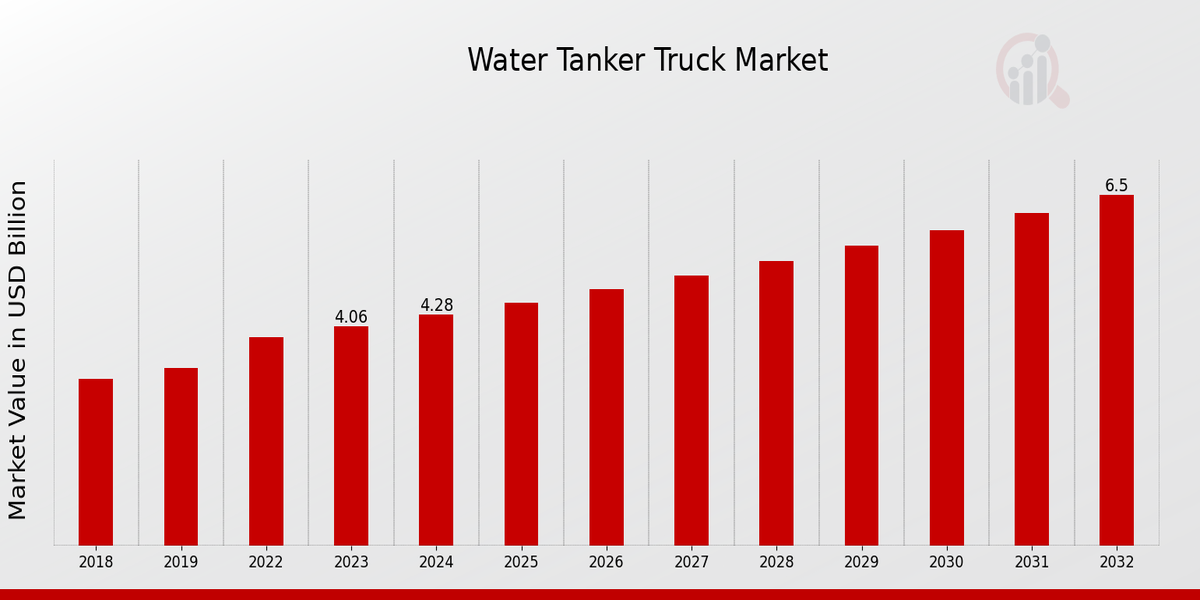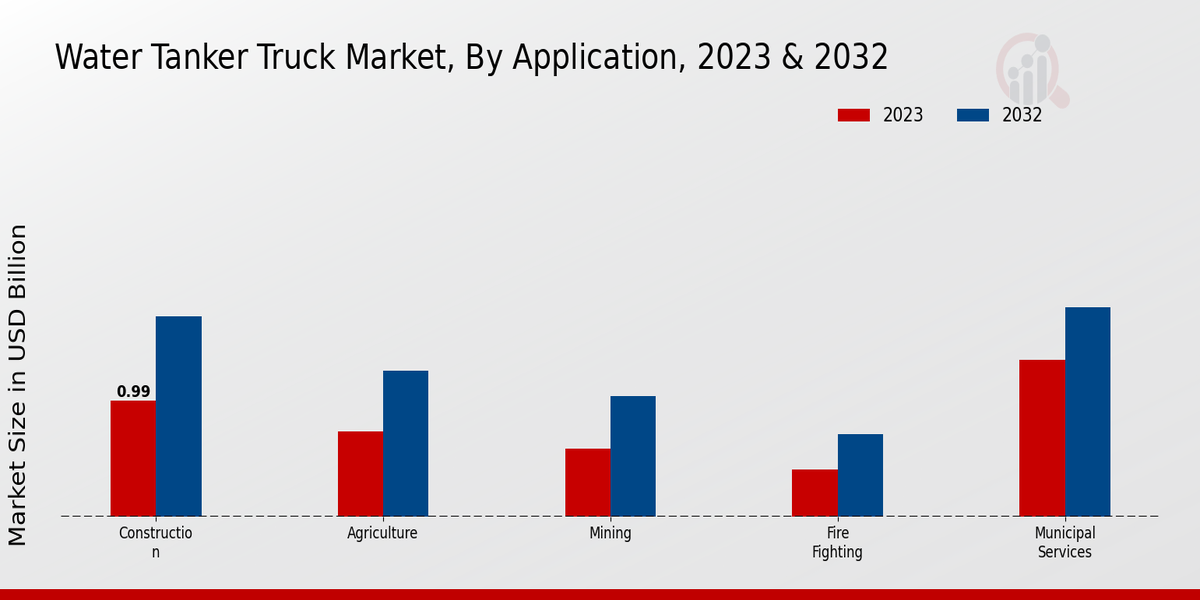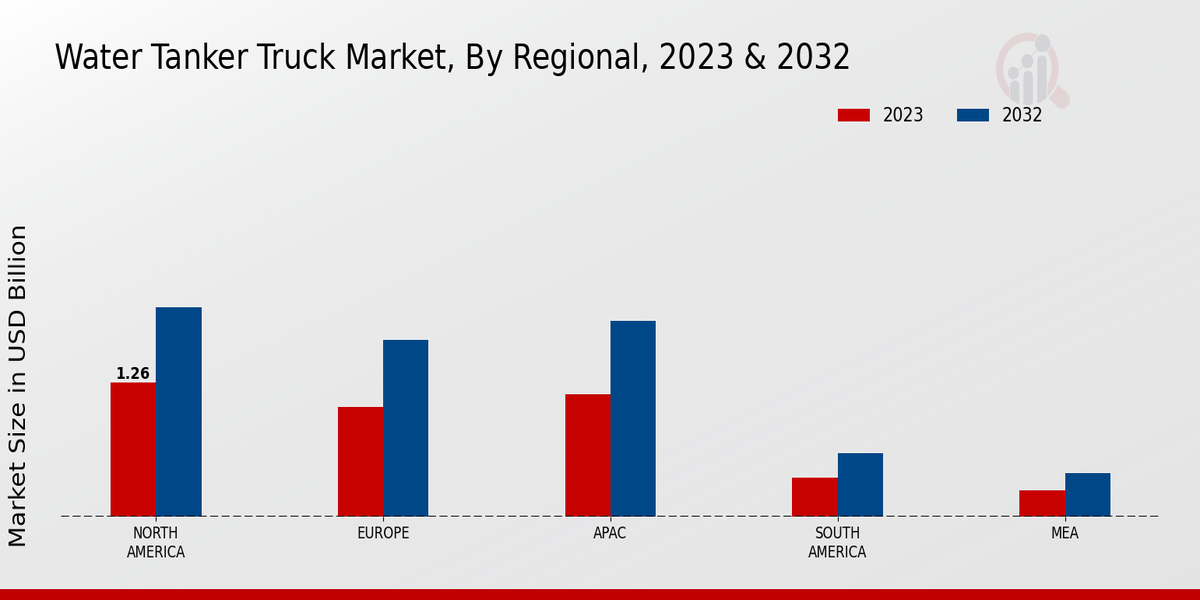Global Water Tanker Truck Market Overview
As per MRFR analysis, the Water Tanker Truck Market Size was estimated at 3.86 (USD Billion) in 2022. The Water Tanker Truck Market is expected to grow from 4.06 (USD Billion) in 2023 to 6.5 (USD Billion) by 2032. The Water Tanker Truck Market CAGR (growth rate) is expected to be around 5.35% during the forecast period (2024 - 2032).
Key Water Tanker Truck Market Trends Highlighted
A number of important factors impact the worldwide market for water tanker trucks. The need for clean water rises as a result of population increase and urbanization, making effective transportation methods necessary.
The necessity of water tanker trucks to transport water to underprivileged communities is highlighted by the lack of access to dependable water sources in many areas.
The industry is also growing as a result of government infrastructure investments driven by growing awareness of water scarcity challenges. Due to their significant water resource requirements, the growth of industries including mining, construction, and agriculture also increases demand for water tanker trucks.
Investing in cutting-edge technology that improve the effectiveness and capacity of water tanker trucks can help seize market opportunities. Water distribution management can be enhanced and routes optimized through the integration of GPS and telematics technology.
Additionally, the growing popularity of environmentally friendly automobiles offers a chance to create water tanker trucks that run on alternate fuels.
Companies can explore partnerships with municipal bodies and industries to address specific water transportation needs, thus expanding their market reach. Recent trends indicate a shift towards more sustainable practices in the water tanker sector.
This includes the adoption of equipment designed to minimize water wastage and the implementation of stricter regulations on vehicle emissions. There is also a noticeable rise in interest in modular and customizable water tanker solutions, allowing businesses to meet diverse requirements.
The focus on improving water quality during transportation has led to advancements in tank materials and designs, ensuring that the water remains safe for consumption. Overall, the market is evolving rapidly, driven by technological advancements and an increasing emphasis on sustainability.

Source: Primary Research, Secondary Research, MRFR Database and Analyst Review
Water Tanker Truck Market Drivers
Growing Demand for Water Supply in Urban Areas
The increasing population in urban areas is driving the demand for efficient water supply solutions, significantly influencing the Water Tanker Truck Market. As urban centers expand, the need for transportation of water to meet the daily requirements of residents becomes crucial.
Water tanker trucks play a pivotal role in ensuring a consistent supply of clean and fresh water to urban households and businesses. Additionally, urban areas often face challenges such as infrastructure constraints and inadequate plumbing facilities, making traditional water delivery systems ineffective.
The use of water tanker trucks serves as a reliable alternative, providing flexibility and accessibility to water supply. Furthermore, with the rise in industrial activities and construction projects in urban settings, the demand for water tanker trucks is projected to grow alongside the need for water in these sectors.
This factor not only boosts the growth of the water tanker truck market but also highlights the importance of these vehicles in maintaining public health and hygiene standards through reliable water delivery.
Government Initiatives for Water Infrastructure Development
Government initiatives focusing on improving water infrastructure are significantly propelling the Water Tanker Truck Market. As authorities recognize the importance of providing adequate water supply for both residential and commercial purposes, investments in infrastructure upgrades and expansion are being prioritized.
This includes the development of new water treatment plants, pipelines, and distribution systems, which often necessitates the use of water tanker trucks for interim water supply solutions.
Consequently, enhanced government spending on water infrastructure not only increases the demand for efficient means of water transport but also creates lucrative opportunities for manufacturers and service providers within the water tanker truck sector. These initiatives serve as a driving force, ensuring that clean water access is prioritized amid rising population densities and urban growth.
Increased Industrial Usage in Various Sectors
The rising demand for water in various industrial sectors is significantly influencing the growth of the Water Tanker Truck Market. Industries such as agriculture, manufacturing, and construction require substantial volumes of water for their operations.
For instance, agricultural activities rely heavily on water tanker trucks for irrigation, especially in regions where natural water sources may be scarce or polluted. Similarly, the manufacturing sector often requires water for processing, cooling, and cleaning processes, necessitating a dependable fleet of water supply vehicles.
The construction industry also demands water for mixing concrete and other materials, further driving the need for efficient water transportation solutions. As industries expand and the focus on sustainable practices increases, the necessity of water tanker trucks becomes more pronounced, consequently enhancing the market landscape.
Water Tanker Truck Market Segment Insights
Water Tanker Truck Market Application Insights
The Water Tanker Truck Market showcased a diverse Application segment comprised of several critical industries that drive its growth. The Construction sector played a major role within this market, valued at 0.995 USD Billion in 2023 and is expected to expand to 1.716 USD Billion by 2032.
This growth reflected an increasing demand for water for concrete mixing and site dust control in construction projects, thus emphasizing its significance as a major contributor.
Agriculture followed closely, representing a vital area with a value of 0.73 USD Billion in 2023 and expected growth to 1.248 USD Billion by 2032, highlighting the essential need for irrigation and support in farming operations.
The Mining sector held a value of 0.586 USD Billion and is forecasted to reach 1.031 USD Billion by 2032, underscoring its role in the extraction processes where water is necessary for dust suppression and mineral processing.
Fire Fighting was another important Application, valued at 0.409 USD Billion in 2023, projected to grow to 0.711 USD Billion by 2032, reflecting its critical need for water during emergency incidents.
Municipal Services represented a dominant segment, with a valuation of 1.34 USD Billion in 2023, anticipated to increase to 1.794 USD Billion by 2032, owing to the consistent demand for clean water supply and waste management in urban areas.
Collectively, these sectors illustrated the broad application and necessity for water tanker trucks across diverse industries, driving ongoing demand and evolution in the Water Tanker Truck Market revenue and segmentation dynamics.
The interplay of these segments revealed opportunities for growth, especially in regions experiencing infrastructural expansion and heightened environmental management efforts. As a whole, the Water Tanker Truck Market was positioned for steady market growth propelled by these integral applications.

Source: Primary Research, Secondary Research, MRFR Database and Analyst Review
Water Tanker Truck Market Tank Material Insights
A key component of this market is the Tank Material segment, which encompasses diverse materials including Steel, Aluminum, Polyethylene, and Fiberglass. Each material offers distinct advantages, with Steel often being favored for its durability and strength, making it suitable for heavy-duty applications. Aluminum, on the other hand, provides lightweight properties that enhance fuel efficiency and ease of operation.
Polyethylene and Fiberglass are increasingly recognized for their corrosion resistance and lower maintenance requirements, appealing to a growing market segment that prioritizes longevity and reduced operational costs.
Market trends indicate a rising demand for sustainable solutions, driving innovation in these materials, while regulatory standards for water safety further underline the importance of reliable tank materials. The Water Tanker Truck Market segmentation reflects these dynamics, showcasing the significant role of tank materials in achieving market growth and meeting the diverse needs of consumers across various industries.
Water Tanker Truck Market Tanker Size Insights
The Water Tanker Truck Market showcases diverse applications across various tanker sizes, including small, medium, and large tankers. Each size plays a crucial role in meeting specific needs; small tankers are predominant in urban settings due to their maneuverability and capacity to fit in restricted areas, while medium tankers are commonly utilized for municipal water supply and construction projects. Large tankers dominate in agricultural and industrial sectors, where higher volumes of water transportation are essential.
This segmentation highlights the growing adaptability of the Water Tanker Truck Market and its response to various consumer demands. Continuous advancements in technology and an increasing focus on sustainable practices present considerable opportunities for market growth.
However, challenges such as regulatory compliance and varying geographical demands can impact efficiencies. Overall, the Water Tanker Truck Market segmentation not only reflects market diversity but also indicates how each tanker size contributes to the overall infrastructure and resource management, ensuring effective water distribution globally.
The statistics related to this market affirm the importance of understanding consumer preferences connected to tanker size, influencing future innovations and product strategies.
Water Tanker Truck Market Fuel Type Insights
Within the market segmentation of Fuel Type, Diesel is a predominant choice, known for its efficiency and robustness in demanding applications. Alternatively, Gasoline presents opportunities in urban environments due to its lower emissions compared to traditional fuels, making it an appealing option for fleet operators focusing on sustainability.
Furthermore, the rise in Alternative Fuels is considerably shaping market dynamics; these fuels are gaining traction due to growing environmental concerns and regulations aimed at reducing greenhouse gas emissions.
The balance among these fuel types illustrates the industry's adaptability, catering to diverse operational requirements while addressing environmental impacts, thus influencing the Water Tanker Truck Market statistics and industry growth. The increasing demand for efficient, eco-friendly solutions represents a significant opportunity for stakeholders to innovate within the Fuel Type segment.
Water Tanker Truck Market Regional Insights
Within this market, North America emerged as a prominent segment, valued at 1.26 USD Billion in 2023, reflecting the region's strong infrastructure and increasing demand for water transport solutions. Following closely was Europe, with a market value of 1.03 USD Billion, driven by rigorous regulations and sustainability initiatives that bolster the use of water tanker trucks.
The APAC region, valued at 1.15 USD Billion, showcased rapid urbanization and industrialization, thus representing a significant growth opportunity.
South America and MEA contributed smaller market shares, valued at 0.37 USD Billion and 0.25 USD Billion, respectively, but have potential for growth due to their developing economies and increasing investments in water management solutions.
Overall, the regional segmentation illustrated diverse opportunities and growth trajectories influenced by local market dynamics and environmental needs. The Water Tanker Truck Market data reflected these trends, showcasing a competitive landscape ready for innovation and expansion within crucial sectors.

Source: Primary Research, Secondary Research, MRFR Database and Analyst Review
Water Tanker Truck Market Key Players and Competitive Insights
The Water Tanker Truck Market has emerged as a pivotal segment within the transportation industry, driven by the increasing demand for efficient water distribution across various sectors, including agriculture, construction, and municipal services. As urbanization continues to rise and water scarcity becomes a more pressing concern, companies are competing to provide robust, reliable, and advanced water tanker trucks that meet the evolving needs of end-users.
This market is characterized by a mixture of established key players and dynamic new entrants, each contributing to innovation and improvements in technology, capacity, and fuel efficiency. Intense competition has led to a range of strategic alliances, mergers, and technological advancements aimed at enhancing product offerings and securing market share in this growing industry.
Mitsubishi Fuso has positioned itself as a significant player in the Water Tanker Truck Market thanks to its long-standing reputation for manufacturing reliable and durable commercial vehicles. The company benefits from its extensive experience and technological expertise, which allow it to develop water tanker trucks that are not only efficient but also tailored to meet specific customer requirements.
Mitsubishi Fuso's strength lies in its ability to integrate advanced features such as fuel-efficient engines and customizable tank capacities, which appeal to various sectors. The company also maintains a wide-reaching distribution network, ensuring that its products are accessible to a broad audience. Additionally, Mitsubishi Fuso is persistent in its commitment to sustainability, investing in green technologies and practices, reinforcing its competitive edge in an increasingly eco-conscious market.
KAMAZ has emerged as a formidable competitor in the Water Tanker Truck Market, leveraging its strong manufacturing capabilities and commitment to innovation. The company's market presence is robust, particularly in regions where heavy-duty trucks are essential for infrastructure development and municipal water services.
KAMAZ is well-regarded for producing water tanker trucks that combine durability with advanced technology, excelling in challenging environments. The company's strengths include competitive pricing, extensive service networks, and models equipped with features that enhance performance, such as powerful engines and off-road capabilities.
KAMAZ continues to focus on research and development, ensuring that it meets the diverse needs of its customers while adapting to shifts in regulations and environmental standards, further solidifying its place in the competitive landscape of the water tanker truck market.
Key Companies in the Water Tanker Truck Market Include
- Mitsubishi Fuso
- KAMAZ
- Volvo
- Tata Motors
- Kenworth
- MAN
- Hino
- Peterbilt
- Ford
- Isuzu
- Freightliner
- Scania
- International
- Mercedes-Benz
- Dongfeng Motor
Water Tanker Truck Market Developments
Significant recent developments in the Water Tanker Truck Market include increased demand for efficient water transportation amidst growing concerns about water scarcity and quality. Companies such as Mitsubishi Fuso, Volvo, and Tata Motors are focusing on enhancing their product offerings with advanced technology and environmentally friendly solutions.
Current affairs reflect a surge in investments aimed at improving infrastructure, particularly in developing regions, which is driving the market's growth. Regarding mergers and acquisitions, there have been notable activities, with companies like Hino and Isuzu exploring strategic partnerships to bolster their market positions and expand product lines.
Additionally, growth in the market valuation of brands like Freightliner and Scania is connected to their ability to innovate and adapt to customer demands, influencing overall market dynamics positively. The industry is witnessing a shift towards sustainable practices, with manufacturers aligning their strategies accordingly, thus enhancing their competitive edge while addressing environmental issues.
-
Water Tanker Truck Market Segmentation Insights
-
Water Tanker Truck Market Application Outlook
- Construction
- Agriculture
- Mining
- Fire Fighting
- Municipal Services
-
Water Tanker Truck Market Tank Material Outlook
- Steel
- Aluminum
- Polyethylene
- Fiberglass
-
Water Tanker Truck Market Tanker Size Outlook
- Small Tankers
- Medium Tankers
- Large Tankers
-
Water Tanker Truck Market Fuel Type Outlook
- Diesel
- Gasoline
- Alternative Fuels
-
Water Tanker Truck Market Regional Outlook
-
North America
-
Europe
-
South America
-
Asia Pacific
-
Middle East and Africa
| Report Attribute/Metric |
Details |
| Market Size 2022 |
3.86(USD Billion) |
| Market Size 2023 |
4.06(USD Billion) |
| Market Size 2032 |
6.5(USD Billion) |
| Compound Annual Growth Rate (CAGR) |
5.35% (2024 - 2032) |
| Report Coverage |
Revenue Forecast, Competitive Landscape, Growth Factors, and Trends |
| Base Year |
2023 |
| Market Forecast Period |
2024 - 2032 |
| Historical Data |
2019 - 2023 |
| Market Forecast Units |
USD Billion |
| Key Companies Profiled |
Mitsubishi Fuso, KAMAZ, Volvo, Tata Motors, Kenworth, MAN, Hino, Peterbilt, Ford, Isuzu, Freightliner, Scania, International, MercedesBenz, Dongfeng Motor |
| Segments Covered |
Application, Tank Material, Tanker Size, Fuel Type, Regional |
| Key Market Opportunities |
Increased demand for clean water, Growth in construction activities, Expansion of the agriculture sector, Rising environmental regulations, Advancements in tanker technology |
| Key Market Dynamics |
Growing water scarcity, Increasing urbanization, Rising industrial demand, Government regulations on water transport, Technological advancements in tankers |
| Countries Covered |
North America, Europe, APAC, South America, MEA |
Frequently Asked Questions (FAQ) :
The projected market size of the Water Tanker Truck Market by 2032 is expected to reach 6.5 billion USD.
The expected CAGR for the Water Tanker Truck Market from 2024 to 2032 is 5.35%.
North America is anticipated to have the largest market share, with a projected valuation of 1.96 billion USD by 2032.
The market size of the Water Tanker Truck Market in Europe for the year 2023 was valued at 1.03 billion USD.
The Construction application segment is expected to grow significantly, increasing from 0.995 billion USD in 2023 to 1.716 billion USD by 2032.
Key players in the Water Tanker Truck Market include Mitsubishi Fuso, KAMAZ, Volvo, Tata Motors, and Kenworth.
The market size of the Agriculture application in the Water Tanker Truck Market is expected to reach 1.248 billion USD by 2032.
The Mining application segment was valued at 0.586 billion USD in the Water Tanker Truck Market for 2023.
The projected market size for the Municipal Services application by 2032 is expected to be 1.794 billion USD.
The South America region is expected to grow to 0.6 billion USD by 2032, reflecting a positive growth trend.

















